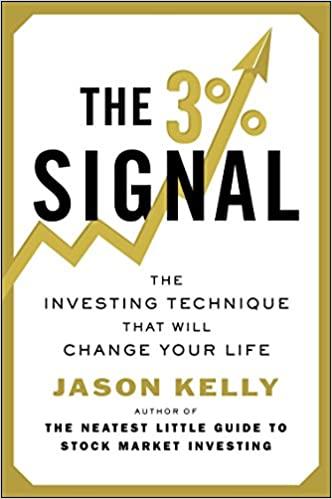Question
3. ( 20 points ) You are considering the investment in stock XYZ. The stock price at the end of this quarter is $50. The
3. (20 points) You are considering the investment in stock XYZ. The stock price at the end of this quarter is $50. The stock pays no dividends.
(a) Suppose your forecast regarding the distribution of stock price at the end of next quarter is as follows:
| State of the Market | Probability | Ending Price | HPR (next quarter) | APR | EAR |
| Boom | 0.20 | $55 | |||
| Normal | 0.55 | $53 | |||
| Recession | 0.25 | $46.5 |
Please fill out the table by computing the HPR in the next quarter, APR and EAR of this stock in each state of the market. Also compute the expectation and standard deviation of quarterly HPR on this stock. Suppose that the current rate of return on 30-day T-bills is 5% and will be constant over the next quarter, what is the quarterly risk premium and Sharpe ratio? (6 points)
(Note: the quoted 30-day T-bills rate is annual rate of return APR.)
(b) In reality, investors do not know the true distribution of stock returns. So we use historical data to estimate the performance of this stock. We can observe the quarterly rate of returns data of stock XYZ in the past 25 years (which is 100 quarters).
(i) If we only use the quarterly return data in the past four quarters: 12%, 5%, 7%, -8%, what are the arithmetic average, geometric average, and standard deviation of the sample rate of return?
If we also observe the quoted 30-day T-bills rate in the past four quarters are 5.6%, 5.2%, 5.2%, 4.4%, what are the sample risk premium and Sharpe ratio? (5 points)
(Note: the quoted 30-day T-bills rate is APR.)
(ii) Discuss the advantage and limitation of previous time-series analysis using the most recent return data. (4 points)
(iii) Now, we use all the 100 quarterly rate of returns data of stock XYZ. The statistics of quarterly excess returns are given in the following table:
| Statistic (Quarterly excess returns) | Performance (%) |
| Average 2.25% SD 6.12% LPSD 6.59% Skew -0.6 Kurtosis 0.94 | VaR actual VaR normal Expected shortfall actual Expected shortfall normal -8.02 -7.82 -10.11 -9.81 |
Compute the Sharpe ratio and Sortino ratio. What does the distribution of excess returns look like, based on these sample statistics? (5 points)
Step by Step Solution
There are 3 Steps involved in it
Step: 1

Get Instant Access to Expert-Tailored Solutions
See step-by-step solutions with expert insights and AI powered tools for academic success
Step: 2

Step: 3

Ace Your Homework with AI
Get the answers you need in no time with our AI-driven, step-by-step assistance
Get Started


